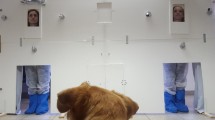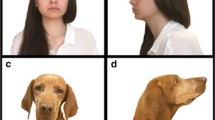Abstract
Researchers have suggested that dogs are able to recognise human faces, but conclusive evidence has yet to be found. Experiment 1 of this study investigated whether dogs can recognise humans using visual information from the face/head region, and whether this also occurs in conditions of suboptimal visibility of the face. Dogs were presented with their owner’s and a stranger’s heads, protruding through openings of an apparatus in opposite parts of the experimental setting. Presentations occurred in conditions of either optimal or suboptimal visibility; the latter featured non-frontal orientation, uneven illumination and invisibility of outer contours of the heads. Instances where dogs approached their owners with a higher frequency than predicted by chance were considered evidence of recognition. This occurred only in the optimal condition. With a similar paradigm, Experiment 2 investigated which of the alterations in visibility that characterised the suboptimal condition accounted for dogs’ inability to recognise owners. Dogs approached their owners more frequently than predicted by chance if outer head contours were visible, but not if heads were either frontally oriented or evenly illuminated. Moreover, male dogs were slightly better at recognition than females. These findings represent the first clear demonstration that dogs can recognise human faces and that outer face elements are crucial for such a task, complementing previous research on human face processing in dogs. Parallels with face recognition abilities observed in other animal species, as well as with human infants, point to the relevance of these results from a comparative standpoint.


Similar content being viewed by others
References
Adachi I, Fujita K (2007) Cross-modal representation of human caretakers in squirrel monkeys. Behav Process 74:27–32. doi:10.1073/pnas.1008169108
Adachi I, Kuwahata H, Fujita K (2007) Dogs recall their owner’s face upon hearing the owner’s voice. Anim Cogn 10:17–21. doi:10.1007/s10071-006-0025-8
Albuquerque N, Guo K, Wilkinson A, Savalli C, Otta E, Mills D (2016) Dogs recognize dog and human emotions. Biol Lett 12:20150883. doi:10.1098/rsbl.2015.0883
Anderson RC, Mather JA, Monette MQ, Zimsen SRM (2010) Octopuses (Enteroctopus dofleini) recognize individual humans. J Appl Anim Welf Sci 13:261–272. doi:10.1080/10888705.2010.483892
Ardila A (1993) People recognition—a historical anthropological perspective. Behav Neurol 6:99–105
Barton JJS, Corrow SL (2016) Recognizing and identifying people: a neuropsychological review. Cortex 75:132–150
Beer CG (1971) Individual recognition of voice in the social behavior of birds. Adv Study Behav 3:27–74. doi:10.1016/S0065-3454(08)60154-0
Boysen ST, Berntson GG (1986) Cardiac correlates of individual recognition in the chimpanzee (Pan troglodytes). J Comp Psychol 100:321–324. doi:10.1037/0735-7036.100.3.321
Braje WL, Kersten D, Tarr MJ, Troje NF (1998) Illumination effects in face recognition. Psychobiology 26:371–380
Brennan PA, Kendrick KM (2006) Mammalian social odours: attraction and individual recognition. Philos Trans R Soc Lond B Biol Sci 361:2061–2078. doi:10.1098/rstb.2006.1931
Campanella S, Belin P (2007) Integrating face and voice in person perception. Trends Cogn Sci 11:535–543. doi:10.1016/j.tics.2007.10.001
Coulon M, Deputte BL, Heyman Y, Baudoin C (2009) Individual recognition in domestic cattle (Bos taurus): evidence from 2D-images of heads from different breeds. PLoS ONE 4(2):e4441. doi:10.1371/journal.pone.0004441
Cuaya LV, Hernández-Pérez R, Concha L (2016) Our faces in the dog’s brain: functional imaging reveals temporal cortex activation during perception of human faces. PLoS ONE 11(3):e0149431. doi:10.1371/journal.pone.0149431
Dyer AG (2005) Honeybee (Apis mellifera) vision can discriminate between and recognise images of human faces. J Exp Biol 208:4709–4714. doi:10.1242/jeb.01929
Grüter T, Grüter M, Carbon CC (2008) Neural and genetic foundations of face recognition and prosopagnosia. J Neuropsychol 2:79–97. doi:10.1348/174866407X231001
Hill H, Schyns PG, Akamatsu S (1997) Information and viewpoint dependence in face recognition. Cognition 62:201–222. doi:10.1016/S0010-0277(96)00785-8
Horn L, Range F, Huber L (2013) Dogs’ attention towards humans depends on their relationship, not only on social familiarity. Anim Cogn 16:435–443. doi:10.1007/s10071-012-0584-9
Huber L, Racca A, Scaf B, Virányi Z, Range F (2013) Discrimination of familiar human faces in dogs (Canis familiaris). Learn Motiv 44:258–269. doi:10.1016/j.lmot.2013.04.005
Johnston RA, Edmonds AJ (2009) Familiar and unfamiliar face recognition: a review. Memory 17:577–596. doi:10.1080/09658210902976969
Jouventin P, Aubin T (2002) Acoustic systems are adapted to breeding ecologies: individual recognition in nesting penguins. Anim Behav 64:747–757. doi:10.1006/anbe.2002.4002
Lee WY, Lee S, Choe JC, Jablonski PG (2011) Wild birds recognize individual humans: experiments on magpies, Pica pica. Anim Cogn 14:817–825. doi:10.1007/s10071-011-0415-4
Levey DJ, Londono GA, Ungvari-Martin J, Hiersoux MR, Jankowski JE, Poulsen JR, Stracey CM, Robinson SK (2009) Urban mockingbirds quickly learn to identify individual humans. Proc Natl Acad Sci 106:8959–8962. doi:10.1073/pnas.0811422106
Martin-Malivel J, Fagot J (2001) Perception of pictorial human faces by baboons: effects of stimulus orientation on discrimination performance. Anim Learn Behav 29:10–20. doi:10.3758/BF03192812
Marzluff JM, Walls J, Cornell HN, Withey JC, Craig DP (2010) Lasting recognition of threatening people by wild American crows. Anim Behav 79:699–707. doi:10.1016/j.anbehav.2009.12.022
Merola I, Prato-Previde E, Marshall-Pescini S (2012) Dogs’ social referencing towards owners and strangers. PLoS ONE 7:e47653. doi:10.1371/journal.pone.0047653
Miller PE, Murphy CJ (1995) Vision in dogs. J Am Vet Med Assoc 207:1623–1634
Mongillo P, Bono G, Regolin L, Marinelli L (2010) Selective attention to humans in companion dogs, Canis familiaris. Anim Behav 80:1057–1063. doi:10.1016/j.anbehav.2010.09.014
Nagasawa M, Murai K, Mogi K, Kikusui T (2011) Dogs can discriminate human smiling faces from blank expressions. Anim Cogn 14:525–533. doi:10.1007/s10071-011-0386-5
Parr LA, Winslow JT, Hopkins WD, de Waal FBM (2000) Recognizing facial cues: individual discrimination by chimpanzees (Pan troglodytes) and rhesus monkeys (Macaca mulatta). J Comp Psychol 114:47–60. doi:10.1037/0735-7036.114.1.47
Peichl L (1992) Topography of ganglion-cells in the dog and wolf retina. J Comp Neurol 324:603–620. doi:10.1002/cne.903240412
Peirce JW, Leigh AE, Dacosta APC, Kendrick KM (2001) Human face recognition in sheep: lack of configurational coding and right hemisphere advantage. Behav Process 55:13–26. doi:10.1016/S0376-6357(01)00158-9
Pitteri E, Mongillo P, Carnier P, Marinelli L, Huber L (2014) Part-based and configural processing of owner’s face in dogs. PLoS ONE 9:e108176. doi:10.1371/journal.pone.0108176
Pretterer G, Bubna-Littitz H (2004) Brightness discrimination in the dog. J Vis 4(3):241–249. doi:10.1167/4.3.10
Proops L, McComb K (2012) Cross-modal individual recognition in domestic horses (Equus caballus) extends to familiar humans. Proc Biol Sci 279:3131–3138. doi:10.1098/rspb.2012.0626
Rennels JL, Cummings AJ (2013) Sex differences in facial scanning: similarities and dissimilarities between infants and adults. Int J Behav Dev 37:111–117. doi:10.1177/0165025412472411
Sayigh LS, Tyack PL, Wells RS, Solow AR, Irvine AB (1999) Individual recognition in wild bottlenose dolphins: a field test using playback experiments. Anim Behav 57:41–50. doi:10.1006/anbe.1998.0961
Sliwa J, Duhamel JR, Pascalis O, Wirth S (2011) Spontaneous voice–face identity matching by rhesus monkeys for familiar conspecifics and humans. Proc Natl Acad Sci 108:1735–1740. doi:10.1073/pnas.1008169108
Somppi S, Törnqvist H, Hänninen L, Krause CM, Vainio O (2014) How dogs scan familiar and inverted faces: an eye movement study. Anim Cogn 17:793–803. doi:10.1007/s10071-013-0713-0
Stephan C, Wilkinson A, Huber L (2012) Have we met before? Pigeons recognise familiar human faces. Avian Biol Res 5:75–80. doi:10.3184/175815512X13350970204867
Thom MD, Hurst JL (2004) Individual recognition by scent. Ann Zool Fennici 41:765–787. doi:10.1007/BF01047985
Tomonaga M, Uwano Y, Ogura S, Chin H, Dozaki M, Saito T (2015) Which person is my trainer? Spontaneous visual discrimination of human individuals by bottlenose dolphins (Tursiops truncatus). Springerplus 4:352. doi:10.1186/s40064-015-1147-8
Topál J, Miklósi Á, Csányi V, Dóka A (1998) Attachment behavior in dogs (Canis familiaris): a new application of Ainsworth’s (1969) strange situation test. J Comp Psychol 112:219–229. doi:10.1037/0735-7036.112.3.219
Troje NF, Kersten D (1999) Viewpoint-dependent recognition of familiar faces. Perception 28:483–487. doi:10.1068/p2901
Turati C, Cassia VM, Simion F, Leo I (2006) Newborns’ face recognition: role of inner and outer facial features. Child Dev 77:297–311. doi:10.1111/j.1467-8624.2006.00871.x
Turati C, Bulf H, Simion F (2008) Newborns’ face recognition over changes in viewpoint. Cognition 106:1300–1321. doi:10.1016/j.cognition.2007.06.005
Acknowledgements
We are very grateful to Pamela Sambugaro and Carlo Poltronieri for their technical assistance and to all the dogs’ owners for volunteering to take part. This research was supported by a research grant from the University of Padova (to P.M., Grant Nr. CPDA144871/14), a postdoc grant awarded by the University of Padova (to A.S., Grant Nr. CPDR148844/14) and a study visit grant awarded by the Experimental Psychology Society (to R.S.S.K.).
Author information
Authors and Affiliations
Corresponding author
Ethics declarations
Conflict of interest
The authors declare that they have no conflict of interests.
Ethical standards
All procedures performed in the present study were in accordance with the ethical standards of the University of Padua and the Italian relevant legislation.
Rights and permissions
About this article
Cite this article
Mongillo, P., Scandurra, A., Kramer, R.S.S. et al. Recognition of human faces by dogs (Canis familiaris) requires visibility of head contour. Anim Cogn 20, 881–890 (2017). https://doi.org/10.1007/s10071-017-1108-4
Received:
Revised:
Accepted:
Published:
Issue Date:
DOI: https://doi.org/10.1007/s10071-017-1108-4




